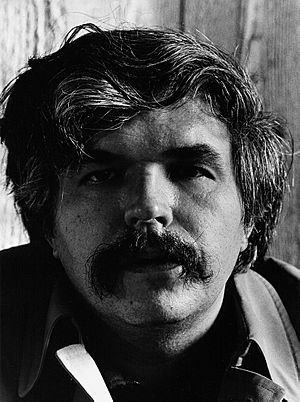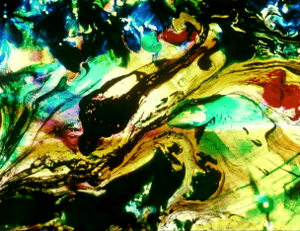Stan Brakhage facts for kids
Quick facts for kids
Stan Brakhage
|
|
|---|---|

Photo of Brakhage by Friedl Kubelka, c. 1976
|
|
| Born |
Robert Sanders
January 14, 1933 Kansas City, Missouri, U.S.
|
| Died | March 9, 2003 (aged 70) Victoria, British Columbia, Canada
|
| Occupation | Film director |
| Years active | 1954–2003 |
| Known for | Experimental film, art film, collage film |
|
Notable work
|
Dog Star Man, Mothlight, Window Water Baby Moving |
James Stanley Brakhage (born Robert Sanders; January 14, 1933 – March 9, 2003) was an American filmmaker. He is known as one of the most important people in experimental film during the 20th century.
For 50 years, Brakhage made many different kinds of films. He used special ways of filming, like holding the camera himself and painting directly onto the film. He also used quick cuts, scratched on the film, and layered images.
Brakhage was interested in mythology and got ideas from music, poetry, and things he saw. He wanted to show universal ideas, especially about birth, life, and death. Most of his films do not have sound.
His films are often known for showing strong feelings and being like poems. For a long time, his films were hard to find. Now, many of them are available on DVD and other ways to watch movies.
Contents
Stan Brakhage's Early Life
Stan Brakhage was born Robert Sanders in Kansas City, Missouri, on January 14, 1933. Three weeks later, he was adopted by Ludwig and Clara Brakhage and given his new name.
As a child, Brakhage sang on the radio and in church choirs. He grew up in Denver, Colorado. There, he went to South High School with other future filmmakers and musicians.
Brakhage briefly went to Dartmouth College on a scholarship. But he soon left to make films. He finished his first film, Interim, when he was 19.
In 1953, Brakhage moved to San Francisco. He met poets like Robert Duncan there. He then moved to New York City in 1954. In New York, he met famous artists like Maya Deren and John Cage. Brakhage even worked with some of them on films.
Becoming a Recognized Filmmaker
Brakhage faced tough times early in his career. He felt his films were not doing well. In 1957, he married Mary Jane Collom, who later became known as Jane Wodening.
To support his family, Brakhage made short films for businesses. In 1958, his daughter Myrrena was born. Brakhage filmed this event for his 1959 movie Window Water Baby Moving.
In the 1950s, people often made fun of Brakhage's early films. But in the early 1960s, he started to get praise. His films won awards from Film Culture magazine.
From 1961 to 1964, Brakhage worked on a series of five films. These are known as the Dog Star Man cycle. In 1964, he moved to Lump Gulch, Colorado.
His film equipment was stolen during a visit to New York. Brakhage bought cheaper 8mm film equipment. He then made 30 short 8mm films called the Songs from 1964 to 1969. One famous film from this time is 23rd Psalm Branch. It was his response to the Vietnam War.
In 1969, Brakhage began teaching film history. He taught at the School of the Art Institute of Chicago.
New Ways of Making Films
In the 1970s, Brakhage tried new ways to make films. In 1971, he made three films about public places in Pittsburgh. These films, Eyes, Deus Ex, and The Act of Seeing with One's Own Eyes, are called "The Pittsburgh Trilogy".
In 1974, he made a long film called The Text of Light. This film showed only images of light shining through a glass ashtray. He also experimented with Polavision cameras.
Through the late 1970s and early 1980s, Brakhage kept exploring light and thoughts. He made films that showed what he called "moving visual thinking." These were abstract films in series like the Roman, Arabic, and Egyptian series.
Stan Brakhage taught at the University of Colorado in Boulder. He taught there on and off during these years.
In 1986, he separated from Jane. In 1989, he married his second wife, Marilyn. They had two children together. In the late 1980s, Brakhage started making films with sound again. He also finished The Dante Quartet, a film painted by hand.
Brakhage received the Edward MacDowell Medal in 1989.
Later Years and Passing
Brakhage continued to make many films in his last two decades. He sometimes worked with other filmmakers, like Phil Solomon. He made more sound films, including Passage Through: A Ritual. He also created the "Vancouver Island Quartet," which explored childhood and growing old.
In 1996, Brakhage became ill with bladder cancer. His illness was linked to the special dyes he used for his films.
Brakhage stopped teaching in 2002. He moved to Canada with his wife Marilyn and their two sons. Stan Brakhage passed away on March 9, 2003, at age 70. His last filmed work is called Work in Progress. He was also working on the Chinese Series, which involved scratching directly onto film.
Even though he was not a practicing Christian as an adult, Brakhage asked for a traditional Anglican funeral. His family and a few friends from the film world attended.
Influence on Other Artists
In 1961, film critic Jonas Mekas called Brakhage "one of the most original filmmakers in America today." Brakhage taught many students who became famous. These include Eric Darnell, who directed Antz, and the creators of South Park, Matt Stone and Trey Parker. He even appeared in their student film Cannibal! The Musical.
Director Martin Scorsese used Brakhage's painted film style in his movie The Last Temptation of Christ. Scorsese even has samples of Brakhage's films on his office wall.
The opening credits of the film Seven (1995) use a style like Brakhage's. They feature scratched film and quick flashes of light.
The band Stereolab named a song "Brakhage" on their 1997 album Dots and Loops.
Sonic Youth played music along with silent Stan Brakhage films in 2003. This was at a show to help the Anthology Film Archives.
The end credits of The Jacket (2005) are a tribute to Brakhage's 1963 film Mothlight.
The opening titles of the BBC show The Living and the Dead (2016) use a part from Mothlight.
The 2011 film The Tree of Life and a part of Twin Peaks: The Return (2017) have scenes that remind people of Brakhage's work.
Filmography
Writings
Brakhage wrote several books about films. These include Metaphors on Vision (1963) and A Moving Picture Giving and Taking Book (1971). His book Telling Time: Essays of a Visionary Filmmaker was published after he passed away.
Archives
Brakhage's old materials, like letters and recordings, are kept at the University of Colorado. His films are held by the Academy Film Archive. This archive has saved and fixed many of his films. These include Window Water Baby Moving and The Act of Seeing with One's Own Eyes.
See also
 In Spanish: Stan Brakhage para niños
In Spanish: Stan Brakhage para niños


